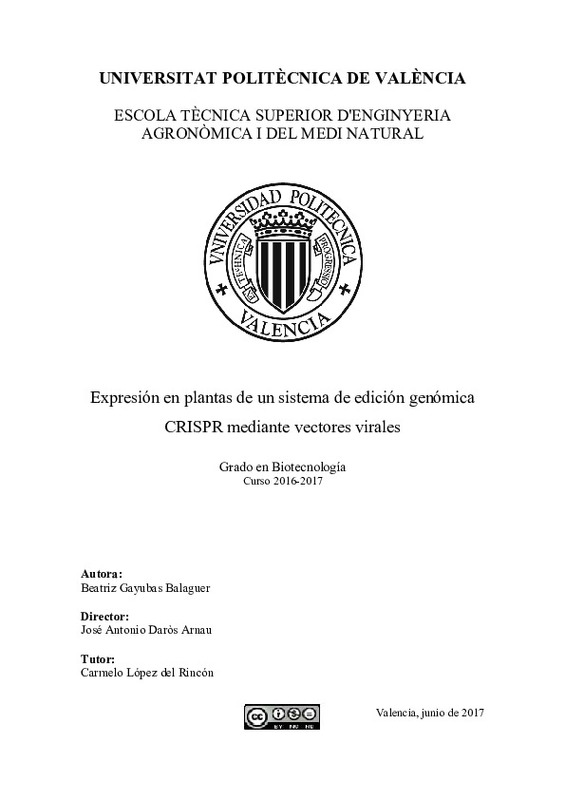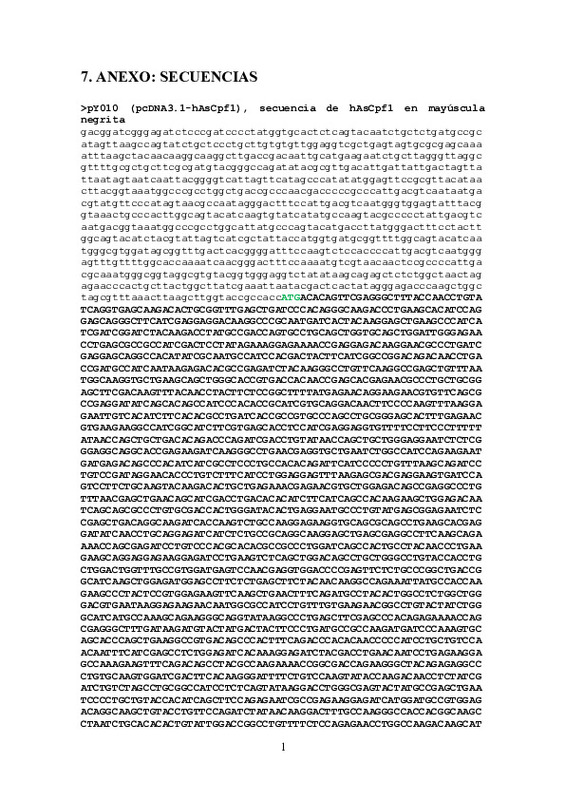JavaScript is disabled for your browser. Some features of this site may not work without it.
Buscar en RiuNet
Listar
Mi cuenta
Estadísticas
Ayuda RiuNet
Admin. UPV
Expresión en plantas de un sistema de edición genómica CRISPR mediante vectores virales
Mostrar el registro sencillo del ítem
Ficheros en el ítem
| dc.contributor.advisor | López Del Rincón, Carmelo
|
es_ES |
| dc.contributor.advisor | Daros Arnau, Jose Antonio
|
es_ES |
| dc.contributor.author | Gayubas Balaguer, Beatriz
|
es_ES |
| dc.date.accessioned | 2017-09-05T11:42:14Z | |
| dc.date.available | 2017-09-05T11:42:14Z | |
| dc.date.created | 2017-07-12 | |
| dc.date.issued | 2017-09-05 | es_ES |
| dc.identifier.uri | http://hdl.handle.net/10251/86439 | |
| dc.description.abstract | [ES] La edición dirigida de genomas en plantas va a revolucionar en los próximos años el campo de la mejora de las variedades vegetales y la biotecnología vegetal. De entre las diferentes técnicas de edición de genomas, el sistema CRISPR-Cas ha sido la que ha destacado notablemente. En origen, CRISPR-Cas forma parte del sistema inmune adaptativo de bacterias y arqueas y les permite atacar a cualquier material genético invasor. Existen dos clases de sistemas CRISPRCas y, dentro de cada una de ellas, distintos tipos. De entre ellos, el sistema de tipo II CRISPRCas9 ha sido el que se ha utilizado para su adaptación a la edición de genomas en células de mamífero y en plantas. Sin embargo, últimamente ha surgido el sistema de tipo V CRISPRCpf1 para la edición de genomas, que tiene algunas características que lo hacen más favorable, como la utilización de un único RNA para la edición. De entre las diferentes proteínas de la familia de la Cpf1, las procedentes de Acidaminococcus sp. (AsCpf1) y Lachnospiraceae bacterium (LbCpf1) han demostrado poseer una actividad editora de genes comparable a la de la Cas9 en células de mamífero y en plantas. En este trabajo se ha explorado la posibilidad de expresar un sistema de edición CRISPR-Cpf1 en plantas mediante vectores virales. Para ello se construyó un vector viral derivado del virus del grabado del tabaco (Tobacco etch virus, TEV) al cual se le insertó el gen de la nucleasa LbCpf1. La construcción del vector se realizó a partir del plásmido pGTEV∆EE, diseñado con el objetivo de crear un vector viral derivado del TEV estable en Escherichia coli y apto para agroinocular plantas. Además, se sabe que a este vector viral se le puede eliminar el gen de la RNA polimerasa viral (NIb) y su función puede ser complementada en trans en células que expresen dicha proteína. Se comprobó que el vector derivado del TEV en el que NIb se reemplazó por LbCpf1 es infeccioso tras agroinocularlo en plantas de Nicotiana tabacum que expresan NIb. Sin embargo, los análisis de la progenie viral en las plantas infectadas indicaron que el virus pierde el inserto de la LbCpf1. No sabemos si el virus expresará la nucleasa un tiempo suficiente para desarrollar su labor de edición genómica. También se construyeron cuatro vectores virales derivados del virus X de la patata (Potato virus X, PVX) a los cuales se les insertaron diferentes construcciones con RNAs CRISPR (crRNAs) para modificar el gen de la fitoeno desaturasa (PDS). Los insertos se componían de las diferentes combinaciones de las repeticiones directas específicas para las nucleasas AsCpf1 o LbCpf1 con las secuencias guía para modificar la PDS de N. tabacum y Nicotiana benthamiana. Mediante agroinoculación de plantas de N. benthamiana, se comprobó que el vector viral que expresa el crRNA correspondiente a LbCpf1 en esta especie es infeccioso. Cuando se dispongan de plantas de N. benthamiana que expresen NIb, cuya construcción está en curso, estos vectores virales se utilizarán para ensayar si es posible editar el genoma de la planta. | es_ES |
| dc.description.abstract | [EN] Genome editing in plants will revolutionize the field of plant breeding and plant biotechnology in the coming years. Among the different genome editingtechniques, the CRISPR-Cas system has stand out so far. In origin, CRISPR-Cas is part of the adaptive immune system of bacteria and archaea and allows them to attack invading genetic material. There are two types of CRISPR-Cas systems and, within each of them, different types. Among them, the CRISPRCas9 type II system has been adapted to genome editing in mammalian cells and plants. However, more recently the CRISPR-Cpf1 type V system has emerged, with some advantageous features, such as the need of a single RNA. Among the different proteins of the Cpf1 family, those from Acidaminococcus sp. (AsCpf1) and Lachnospiraceae bacterium (LbCpf1) have comparable gene editing activity to that of Cas9 in mammalian cells and plants. In this work, we have explored the possibility of expressing a CRISPR-Cpf1 editing system in plants using viral vectors. We constructed a viral vector derived from the Tobacco etch virus (TEV) in which the nuclease gene LbCpf1 was inserted. The vector was made from the plasmid pGTEVΔEE, designed with the objective of creating a TEV-derived viral vector stable in Escherichia coli and suitable for plantagroinoculation. In addition, it is known that from this viral vector, the viral RNA polymerase (NIb) gene can be deleted while the function can be complemented in trans in cells expressing this protein. The TEV-derived vector in which NIb was replaced by LbCpf1 was infectious after agroinoculation ofNIb-expressing Nicotianatabacum plants. However, the analysis of the viral progeny in the infected plants indicated that the virus loses the LbCpf1 insert. We do not know if the virus will express the nuclease long enough to develop its genomic editing work. Four Potato virusX (PVX)-derived virus vectors were also built and different constructs were inserted inside with CRISPR-RNAs (crRNAs) to modify the phytoene desaturase (PDS) gene. The inserts were composed of the different combinations of the direct repeats specific for the nucleases AsCpf1 or LbCpf1 with the guide sequences to modify the PDS of N. tabacum and Nicotiana benthamiana. By agroinoculation ofN. benthamianaplants, we confirmed that the viral vector that expresses the crRNA corresponding to LbCpf1 is infectious in this species. When N. benthamiana plants expressing NIb, which are under construction, are available, these viral vectors will be used to test whether it is possible to edit the genome of the plant. | es_ES |
| dc.format.extent | 45 | es_ES |
| dc.language | Español | es_ES |
| dc.publisher | Universitat Politècnica de València | es_ES |
| dc.rights | Reconocimiento - No comercial - Sin obra derivada (by-nc-nd) | es_ES |
| dc.subject | Plant viruses | es_ES |
| dc.subject | Viral vectors | es_ES |
| dc.subject | Genome edition | es_ES |
| dc.subject | CRISPR | es_ES |
| dc.subject | Virus de plantas | es_ES |
| dc.subject | Vectores virales | es_ES |
| dc.subject | Edición genoma | es_ES |
| dc.subject.classification | GENETICA | es_ES |
| dc.subject.classification | MICROBIOLOGIA | es_ES |
| dc.subject.other | Grado en Biotecnología-Grau en Biotecnologia | es_ES |
| dc.title | Expresión en plantas de un sistema de edición genómica CRISPR mediante vectores virales | es_ES |
| dc.type | Proyecto/Trabajo fin de carrera/grado | es_ES |
| dc.rights.accessRights | Abierto | es_ES |
| dc.contributor.affiliation | Universitat Politècnica de València. Escuela Técnica Superior de Ingeniería Agronómica y del Medio Natural - Escola Tècnica Superior d'Enginyeria Agronòmica i del Medi Natural | es_ES |
| dc.contributor.affiliation | Universitat Politècnica de València. Departamento de Biotecnología - Departament de Biotecnologia | es_ES |
| dc.description.bibliographicCitation | Gayubas Balaguer, B. (2017). Expresión en plantas de un sistema de edición genómica CRISPR mediante vectores virales. http://hdl.handle.net/10251/86439 | es_ES |
| dc.description.accrualMethod | TFGM | es_ES |
| dc.relation.pasarela | TFGM\66534 | es_ES |
Este ítem aparece en la(s) siguiente(s) colección(ones)
-
ETSIAMN - Trabajos académicos [3541]
Escuela Técnica Superior de Ingeniería Agronómica y del Medio Natural







